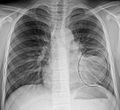Classification of pneumonia

Editor-In-Chief: Prab R Tumpati, MD
Obesity, Sleep & Internal medicine
Founder, WikiMD Wellnesspedia &
W8MD medical weight loss NYC and sleep center NYC
| Classification of pneumonia | |
|---|---|

| |
| Synonyms | N/A |
| Pronounce | N/A |
| Specialty | N/A |
| Symptoms | Cough, fever, chest pain, difficulty breathing |
| Complications | Lung abscess, pleural effusion, sepsis |
| Onset | Rapid or gradual |
| Duration | Varies |
| Types | N/A |
| Causes | Bacteria, viruses, fungi, aspiration |
| Risks | Smoking, COPD, immunosuppression, age |
| Diagnosis | Chest X-ray, sputum culture, blood tests |
| Differential diagnosis | Bronchitis, pulmonary embolism, lung cancer |
| Prevention | Vaccination, hand hygiene, smoking cessation |
| Treatment | Antibiotics, antiviral drugs, oxygen therapy |
| Medication | N/A |
| Prognosis | Generally good with treatment, varies by type |
| Frequency | Common |
| Deaths | N/A |
Pneumonia is an inflammatory condition of the lung primarily affecting the small air sacs known as alveoli. Typically, symptoms include some combination of productive or dry cough, chest pain, fever, and trouble breathing. Severity is variable. Pneumonia is usually caused by infection with viruses or bacteria and less commonly by other microorganisms, certain medications, or conditions such as autoimmune diseases.
Classification[edit]
Pneumonia can be classified in several ways, most commonly by where it was acquired (community, hospital, or health care associated), by the causative organism, and by the area of lung affected.
By Acquisition[edit]
- Community-Acquired Pneumonia (CAP): This is the most common type of pneumonia. It occurs outside of hospitals or other health care facilities. It is commonly caused by bacteria, with Streptococcus pneumoniae being the most common.
- Hospital-Acquired Pneumonia (HAP): This type of pneumonia occurs 48 hours or more after admission to a hospital and was not present at the time of admission. It is often more serious because the bacteria involved may be more resistant to antibiotics.
- Ventilator-Associated Pneumonia (VAP): A subset of HAP, this occurs in people who are on mechanical ventilation through an endotracheal or tracheostomy tube.
- Healthcare-Associated Pneumonia (HCAP): This type occurs in people who have been in other health care facilities, like nursing homes or dialysis centers, within the last 90 days.
By Causative Organism[edit]
- Bacterial Pneumonia: Caused by bacteria, the most common being Streptococcus pneumoniae. Other bacteria include Haemophilus influenzae and Legionella pneumophila.
- Viral Pneumonia: Caused by various viruses, including influenza, respiratory syncytial virus (RSV), and SARS-CoV-2, the virus responsible for COVID-19.
- Fungal Pneumonia: More common in individuals with weakened immune systems, fungal pneumonia can be caused by organisms such as Pneumocystis jirovecii, Cryptococcus neoformans, and Histoplasma capsulatum.
By Area of Lung Affected[edit]
- Lobar Pneumonia: Involves a specific lobe or lobes of the lung.
- Bronchopneumonia: Affects patches throughout both lungs.
Diagnosis[edit]
Diagnosis of pneumonia often involves a combination of physical signs, chest X-rays, and a person's sputum being tested with culture or antigen detection tests. Blood tests and CT scans are also sometimes used to diagnose pneumonia or to determine the severity of the disease.
Treatment[edit]
Treatment depends on the underlying cause of pneumonia. Bacterial pneumonia is treated with antibiotics. Viral pneumonia may require antiviral medication, though in many cases, treatment is supportive. Fungal pneumonia is treated with antifungal agents.
Prevention[edit]
Preventative measures include vaccination, appropriate hand hygiene, and smoking cessation. Vaccines are available for some causes of bacterial and viral pneumonia.
Prognosis[edit]
The prognosis for pneumonia varies widely depending on the type of pneumonia, the treatment received, and the patient's underlying health conditions. While most people recover from pneumonia, it can be life-threatening, particularly for the elderly, infants, and those with weakened immune systems or chronic diseases.
Gallery[edit]
-
Wedge-shaped pneumonia
-
Normal AP chest X-ray
-
Normal lateral chest X-ray
-
Left lower lobe pneumonia with effusion
-
Right lower lobe pneumonia
-
Pneumonia example 1
-
Right upper lobe pneumonia
-
Left lower lobe pneumonia
-
Right lower lobe pneumonia
Ad. Transform your life with W8MD's Budget GLP-1 injections from $75


W8MD offers a medical weight loss program to lose weight in Philadelphia. Our physician-supervised medical weight loss provides:
- Weight loss injections in NYC (generic and brand names):
- Zepbound / Mounjaro, Wegovy / Ozempic, Saxenda
- Most insurances accepted or discounted self-pay rates. We will obtain insurance prior authorizations if needed.
- Generic GLP1 weight loss injections from $75 for the starting dose.
- Also offer prescription weight loss medications including Phentermine, Qsymia, Diethylpropion, Contrave etc.
NYC weight loss doctor appointmentsNYC weight loss doctor appointments
Start your NYC weight loss journey today at our NYC medical weight loss and Philadelphia medical weight loss clinics.
- Call 718-946-5500 to lose weight in NYC or for medical weight loss in Philadelphia 215-676-2334.
- Tags:NYC medical weight loss, Philadelphia lose weight Zepbound NYC, Budget GLP1 weight loss injections, Wegovy Philadelphia, Wegovy NYC, Philadelphia medical weight loss, Brookly weight loss and Wegovy NYC
|
WikiMD's Wellness Encyclopedia |
| Let Food Be Thy Medicine Medicine Thy Food - Hippocrates |
Medical Disclaimer: WikiMD is not a substitute for professional medical advice. The information on WikiMD is provided as an information resource only, may be incorrect, outdated or misleading, and is not to be used or relied on for any diagnostic or treatment purposes. Please consult your health care provider before making any healthcare decisions or for guidance about a specific medical condition. WikiMD expressly disclaims responsibility, and shall have no liability, for any damages, loss, injury, or liability whatsoever suffered as a result of your reliance on the information contained in this site. By visiting this site you agree to the foregoing terms and conditions, which may from time to time be changed or supplemented by WikiMD. If you do not agree to the foregoing terms and conditions, you should not enter or use this site. See full disclaimer.
Credits:Most images are courtesy of Wikimedia commons, and templates, categories Wikipedia, licensed under CC BY SA or similar.
Translate this page: - East Asian
中文,
日本,
한국어,
South Asian
हिन्दी,
தமிழ்,
తెలుగు,
Urdu,
ಕನ್ನಡ,
Southeast Asian
Indonesian,
Vietnamese,
Thai,
မြန်မာဘာသာ,
বাংলা
European
español,
Deutsch,
français,
Greek,
português do Brasil,
polski,
română,
русский,
Nederlands,
norsk,
svenska,
suomi,
Italian
Middle Eastern & African
عربى,
Turkish,
Persian,
Hebrew,
Afrikaans,
isiZulu,
Kiswahili,
Other
Bulgarian,
Hungarian,
Czech,
Swedish,
മലയാളം,
मराठी,
ਪੰਜਾਬੀ,
ગુજરાતી,
Portuguese,
Ukrainian









